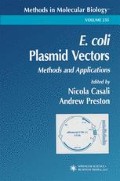Abstract
Since it was described in 1988 (1), the polymerase chain reaction (PCR) has been a valuable tool for molecular biologists. PCR allows researchers to produce a large quantity of a desired DNA fragment while requiring only a small amount of template. Prior to PCR, isolation of DNA fragments was typically performed by cleavage of the DNA with restriction endonuclease enzymes. The relative abundance or scarcity of appropriate restriction sites within the region of interest greatly affected the ability of researchers to obtain specific DNA fragments. PCR gives researchers the ability to establish the terminal sequences as well as the size of the amplified fragment and, in this way, provides freedom from the problems associated with location and abundance of restriction enzyme recognition sites.
References
Saiki, R. K., Gelfand, D. H., Stoffel, S., et al. (1988) Primer-directed enzymatic amplification of DNA with a thermostable DNA polymerase. Science 239, 487–491.
Clark, J. M. (1988) Novel non-template nucleotide addition reactions catalyzed by procaryotic and eucaryotic DNA polymerases. Nucleic Acids Res. 16, 9677–9686.
Hawke, N. A., Strong, S. J., Haire, R. N., et al. (1997) Vector for positive selection of in-frame genetic sequences. BioTechniques 23, 619–621.
Schutte, B. C., Ranade, K., Pruessner, J., et al. (1997) Optimized conditions for cloning PCR products into an XcmI T-vector. BioTechniques 22, 40–44.
Bielefeldt-Ohmann, H. and Fitzpatrick, D. R. (1997) High-efficiency T-vector cloning of PCR products by forced A tagging and post-ligation restriction enzyme digestion. BioTechniques 23, 822–826.
Tsang, T. C., Harris, D. T., Akporiaye, E. T., et al. (1996) Simple method for adapting DNA fragments and PCR products to all of the commonly used restriction sites. BioTechniques 20, 51–52.
Borovkov, A. Y. and Rivkin, M. I. (1997) XcmI-containing vector for direct cloning of PCR products. BioTechniques 22, 812–814.
Marchuk, D., Drumm, M., Saulino, A., et al. (1991) Construction of T-vectors, a rapid and general system for direct cloning of unmodified PCR products. Nucleic Acids Res. 19, 1154.
Author information
Authors and Affiliations
Editor information
Editors and Affiliations
Rights and permissions
Copyright information
© 2003 Humana Press Inc.
About this protocol
Cite this protocol
Nichols, W.A. (2003). Cloning PCR Products with T-Vectors. In: Casali, N., Preston, A. (eds) E. coli Plasmid Vectors. Methods in Molecular Biology™, vol 235. Humana Press. https://doi.org/10.1385/1-59259-409-3:141
Download citation
DOI: https://doi.org/10.1385/1-59259-409-3:141
Publisher Name: Humana Press
Print ISBN: 978-1-58829-151-6
Online ISBN: 978-1-59259-409-2
eBook Packages: Springer Protocols

